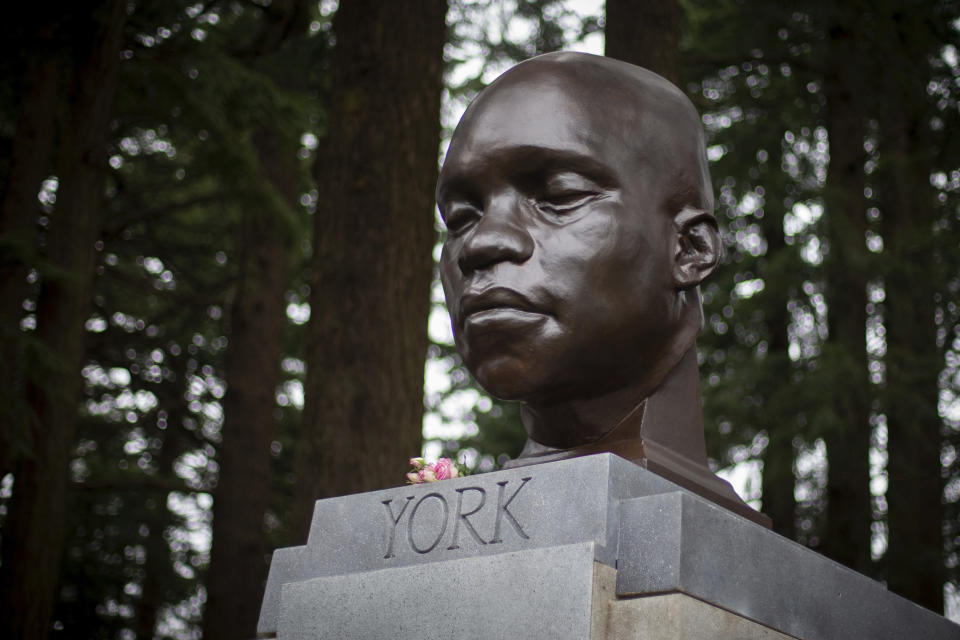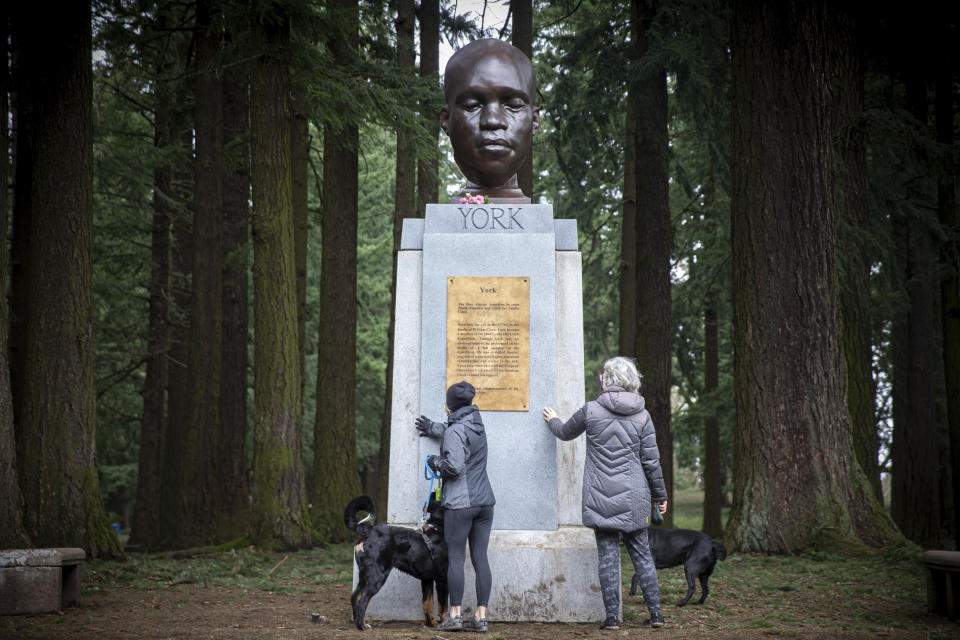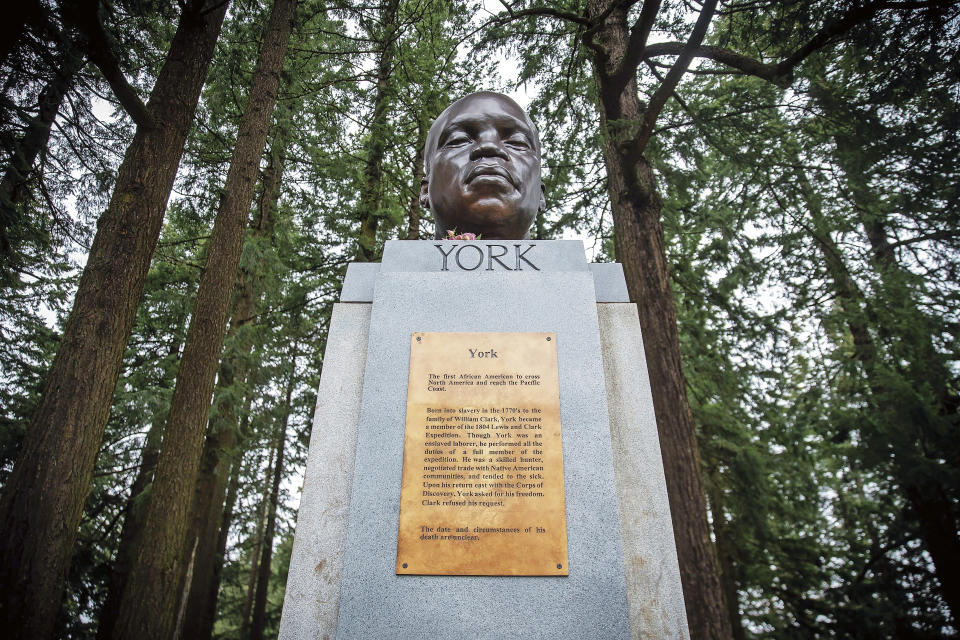Bust of Black hero of Lewis & Clark trip goes up in Portland
- Oops!Something went wrong.Please try again later.
Last year, protesters against racial injustice toppled numerous statues around the country. Now, one of the first works of art to emerge in their place depicts an unsung hero of the Lewis and Clark expedition.
A huge bust of York, a Black man who was enslaved by William Clark and who was the first African-American to cross the continent and reach the Pacific Ocean, is sitting atop a pedestal amid a lushly forested park in Portland, Oregon. It was placed there in the dead of night last weekend by persons unknown.
People have flocked to the bust, which seems to be at least four feet tall, in Mount Tabor Park. The artist's depiction of York shows him seemingly deep in thought or even sad, his eyes cast downward. York hadn’t been painted contemporaneously so how his face really looked is unknown.
Officials in the city, which has been an epicenter of Black Lives Matter protests since the killing of George Floyd, love what the head of the parks department called “guerrilla art.”
“This past summer, there's been concern about some of the public art that many states have displayed, and so folks really see this installation as a bit of a reckoning," Portland Parks and Recreation Director Adena Long said in an interview. "The story of York is really compelling and very sad.”
Passersby stare up at the bust or touch the tall stone pedestal. The anonymous artist affixed a plaque describing how York was an integral part of the 1804-1806 expedition to find an all-water route to the Pacific, but then was denied his freedom by Clark after it was over.
Since the killing of Floyd in Minneapolis last May, hundreds of symbols of racism and other dark chapters of U.S. history have been removed. Among them were at least 167 Confederate symbols, according to the Southern Poverty Law Center.
Pedestals that used to support statues that were torn down by Black Lives Matter protesters or removed by officials now are empty. One, in Virginia, held a monument to Jefferson Davis; others held memorials to Confederate soldiers in Florida, North Carolina, and Alabama; another bore a statue of Robert E. Lee, in Alabama.
Simply renaming places has been easier. At least 14 schools — mostly in the south — were renamed last year. For example, Robert E. Lee High School, in Springfield, Virginia, became John R. Lewis High School, named for the late civil rights leader and congressman from Georgia.
“John R. Lewis, by his lifetime of service, strength, conviction and dedication to improving the lives of others, is memorialized as an enduring symbol through his namesake high school,” the school district says.
Deciding what to replace downed statues with, commissioning the artists and having the work done takes time.
Whoever made the gigantic head of York circumvented all that by producing the bust — officials believe it might have been done with a 3D printer — getting it into the park without being detected and then placing it on top of the pedestal, which itself is around 10 feet (3 meters) high).
It's likely the artist had collaborators to install it. On Friday night, as is customary, park rangers shut gates on the roads and locked them at 10 p.m. closing time. On Saturday morning, a maintenance worker saw the York bust, perched on a pedestal where a statue of a conservative figure who opposed women's right to vote had stood until someone knocked it over last year.
“None of those gates had been damaged. None of those locks had been damaged. And so we do feel that this was brought in on foot,” said Tim Collier, community relations manager for the city parks department.
They had to transport the bust, which seems to be composed of plastic or composite of synthetic material, at least 1,000 feet (300 meters) uphill from the nearest road access.
The mysterious appearance of the bust has prompted many to look up York's story.
In the epic expedition, York had gone on scouting missions, had hunted buffalo and deer to feed the group and helped tend to the sick.
Historian Stephen Ambrose, in his book “Undaunted Courage” about the expedition, described York as “strong, agile, a natural athlete.” Native Americans were fascinated by the first Black person they had ever seen.
“They did not look upon him as a slave or as a mere man, but as an extraordinary person more interesting and elevated than any of his companions,” the National Park Service says in a brief biography.
After the expedition was over, everyone but York was rewarded with money and land. York, whose wife was also a slave and lived in another town, demanded freedom as a reward for his services on the expedition, Ambrose wrote. But Clark refused and even gave him “a Severe trouncing” for being insolent.
Clark later claimed to a friend that he'd freed York. Historians haven't been able to verify that.
Collier said that in the legends of the expedition, York's role has been overlooked, and that the bust “is really furthering that conversation here in our very, very white city.”
Long hopes the artist comes forward to possibly have a conversation about making York a permanent art installation.
___
Follow Andrew Selsky on Twitter at https://twitter.com/andrewselsky



